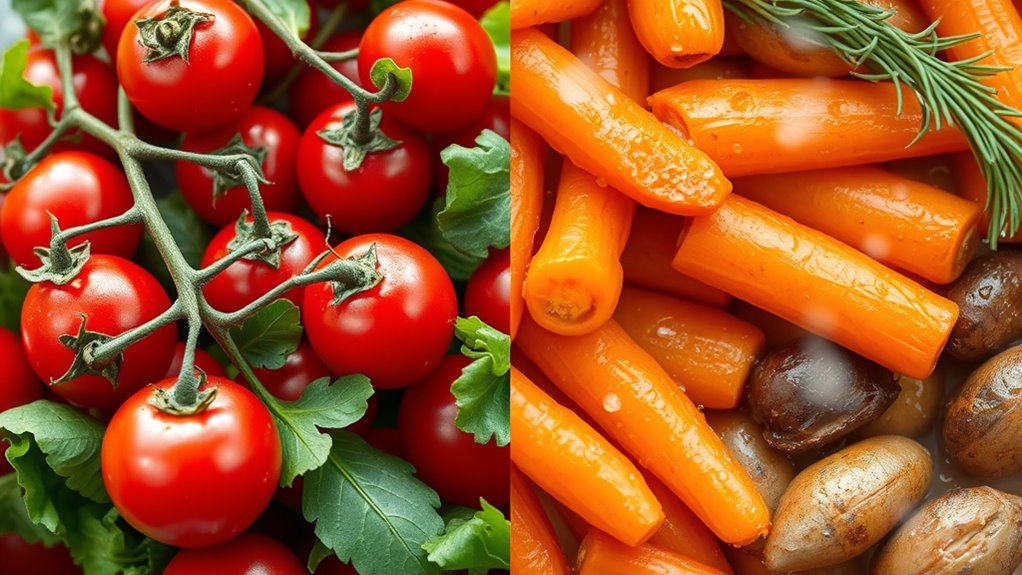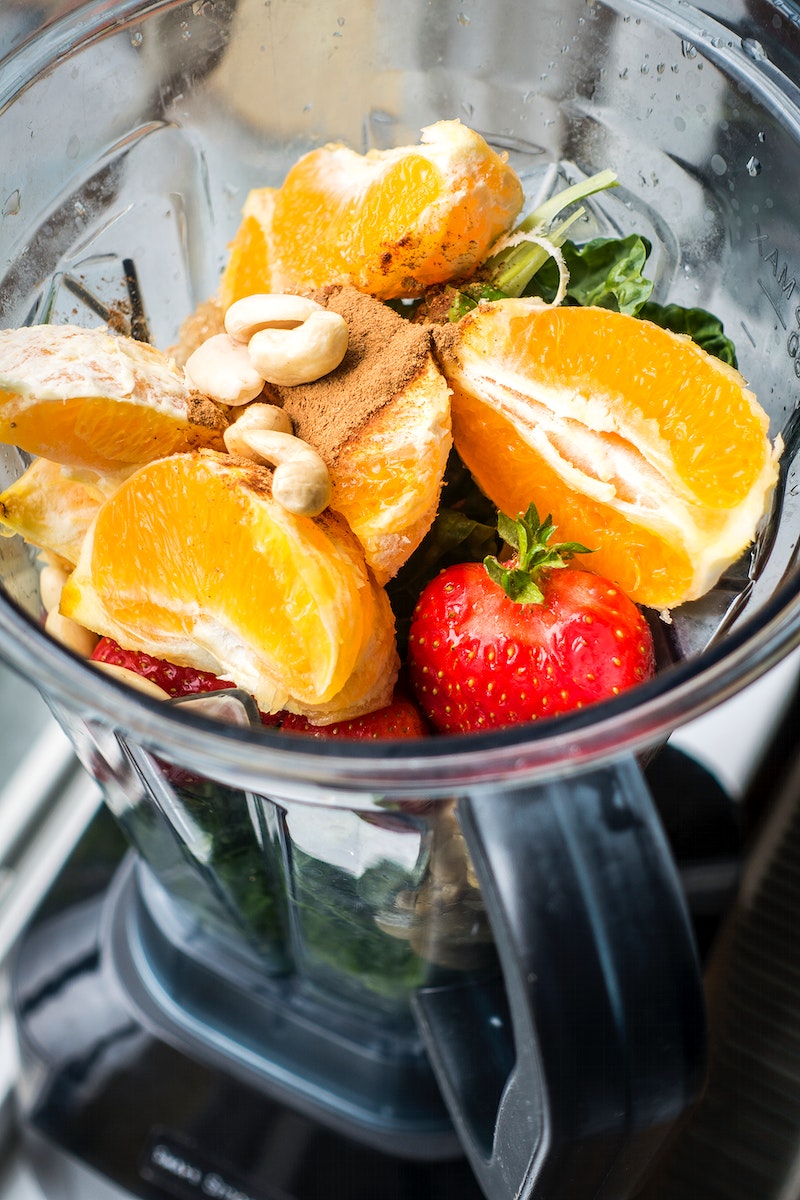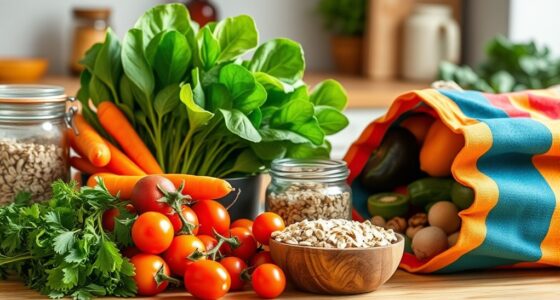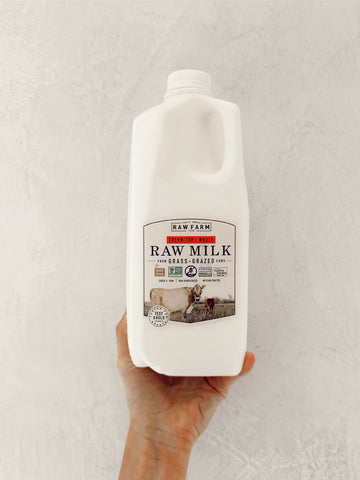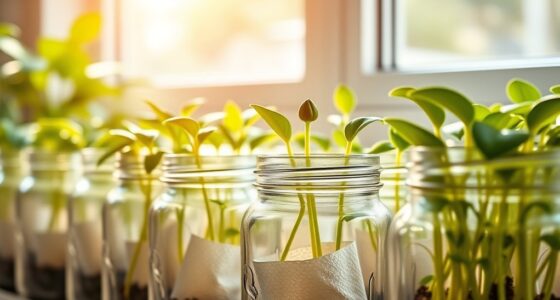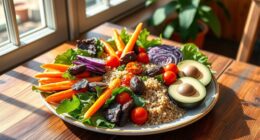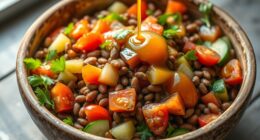Cooking can reduce some vitamins, like C and B-complex, especially with high heat or long durations. Minerals generally stay stable but can be lost if they leach into cooking water. Steaming or microwaving helps preserve nutrients better than boiling. Cooking also softens fiber and improves digestibility, but it may destroy delicate phytochemicals. Choosing the right techniques boosts nutrient retention—if you stick around, you’ll discover more ways to maximize your foods’ health benefits.
Key Takeaways
- Cooking often reduces heat-sensitive vitamins like C and B-complex, especially with prolonged or high-temperature methods.
- Water-soluble vitamins can leach into cooking water, decreasing nutrient content in the food.
- Steaming and microwaving better preserve nutrients compared to boiling or frying.
- Minerals are generally stable but can be lost through leaching into water during cooking.
- Cooking enhances digestibility and can increase the bioavailability of certain phytochemicals, despite some nutrient loss.
Impact of Cooking on Vitamin Content
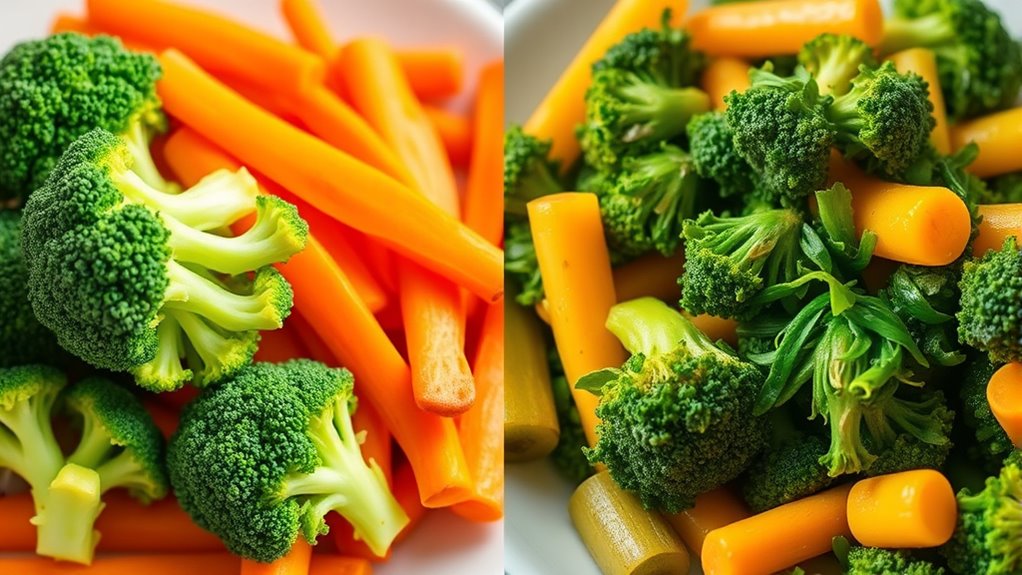
Cooking can substantially affect the vitamin content of foods, often reducing their nutritional value. When you cook, vitamin bioavailability can change—sometimes increasing it by breaking down cell walls and making nutrients easier to absorb. However, heat-sensitive vitamins like C and B-complex are at risk of nutrient loss during storage and cooking. Prolonged heating or high temperatures accelerate vitamin degradation, leading to lower levels in your meal. Additionally, cooking methods like boiling can cause water-soluble vitamins to leach into cooking water, which you might discard. To maximize vitamin retention, choose cooking techniques that preserve nutrients, such as steaming or microwaving, and consume stored foods promptly. Being mindful of these factors helps you retain more vitamins and boost your overall nutrient intake. Proper storage and minimal cooking time can also help maintain nutrient levels, especially for delicate vitamins like vitamin C. For example, using gentle cooking methods can significantly lessen nutrient loss. Incorporating nutrient preservation techniques like blanching or using minimal water can further protect vitamins during preparation. Emphasizing creative storytelling in food presentation and education can also inspire healthier cooking habits.
Mineral Stability in Raw and Cooked Foods
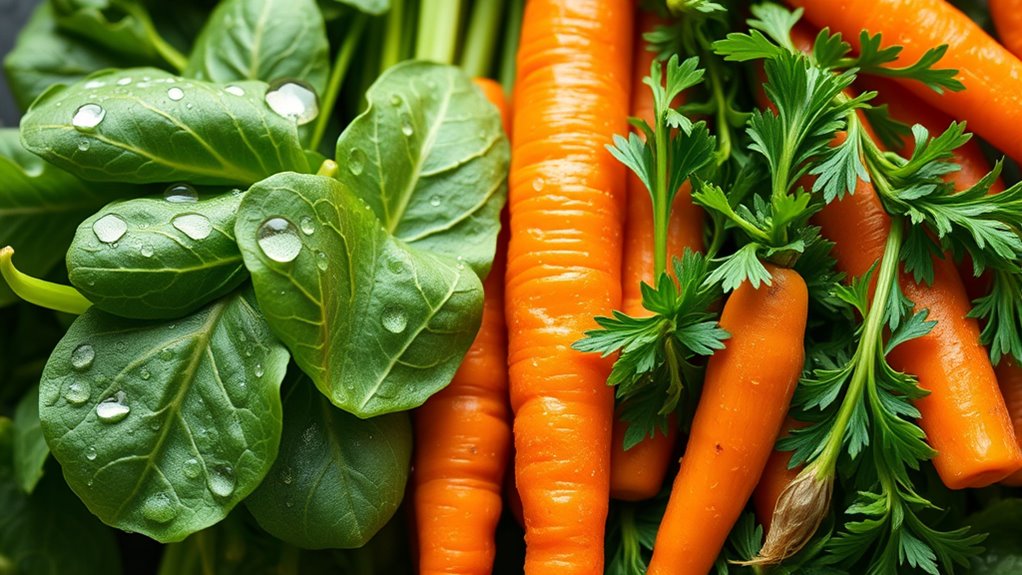
While minerals are generally more stable than vitamins during cooking, their retention still depends on the method used. Mineral leaching occurs when minerals dissolve into cooking water, which can markedly reduce their content in the food. To minimize this, using less water or cooking foods with the water they’re cooked in helps preserve minerals. Additionally, pH effects influence mineral stability; acidic environments can cause certain minerals to leach out more easily, while alkaline conditions may help retain them. Steaming or roasting often results in less mineral loss compared to boiling, which exposes foods directly to water. Cooking methods significantly impact mineral retention, so selecting appropriate techniques is key to maintaining nutritional value. Understanding these factors allows you to choose cooking methods that best preserve mineral content, ensuring you get the maximum nutritional benefit from your foods. Employing climate control techniques like proper temperature regulation during cooking can also help retain minerals by preventing unnecessary heat exposure that may cause leaching. Moreover, being aware of nutrient stability principles can guide you in optimizing your cooking practices for better health outcomes. For example, using less water during boiling or steaming can further reduce mineral loss, especially for water-soluble minerals.
Influence of Heat on Antioxidants and Phytochemicals
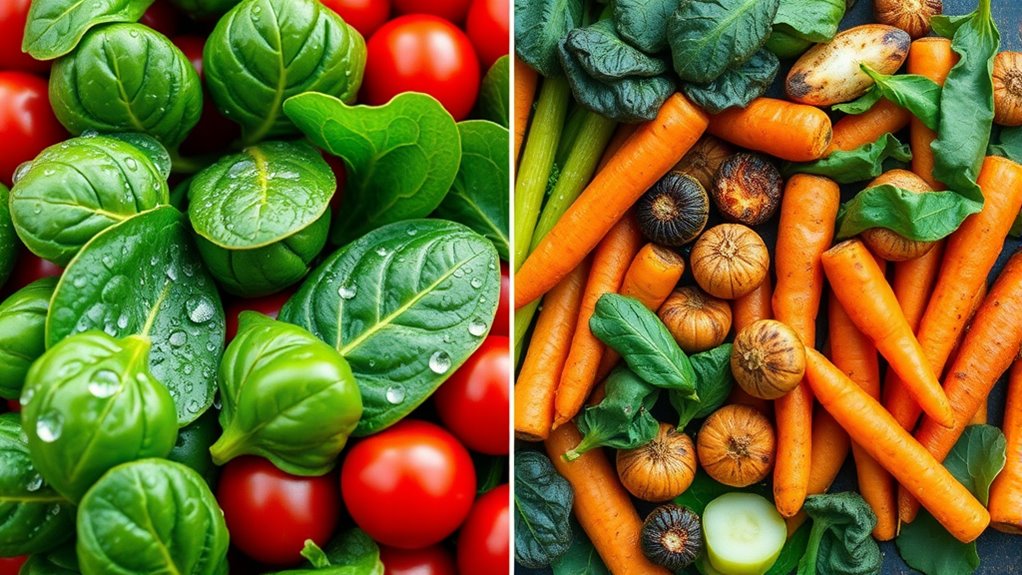
Heat can break down many antioxidants, reducing their health benefits in cooked foods. However, it can also increase the availability of certain phytochemicals, making them easier for your body to absorb. Understanding how heat affects these compounds helps you choose the best way to prepare your foods.
Heat Degrades Antioxidants
When foods are exposed to high temperatures, their antioxidants and phytochemicals can break down rapidly. This degradation reduces their health benefits but can also influence flavor enhancement and texture modification. For example, heat can diminish antioxidants like vitamin C, impacting nutrient value. Additionally, certain cooking methods can help preserve these nutrients, especially when combined with proper temperature control. Some studies suggest that gentle cooking techniques, such as steaming or blanching, can minimize nutrient loss and maintain the nutritional integrity of foods. Understanding how thermal processing affects nutrient retention is essential for maximizing health benefits. Moreover, research indicates that food processing methods play a significant role in preserving or destroying vital nutrients during cooking.
Cooking Enhances Phytochemicals
Contrary to the common belief that heat only degrades nutrients, certain cooking methods can actually increase the availability of phytochemicals in foods. Heat can break down cell walls, promoting flavonoid enhancement and making these compounds easier for your body to digest. For example, lightly cooking vegetables like tomatoes and carrots boosts their antioxidant capacity by releasing more phytochemicals. The process of phytochemical digestion becomes more efficient as heat helps *access* these nutrients from their plant matrix. Additionally, understanding how nutrient bioavailability is affected by cooking can guide you in preparing foods that maximize health benefits. Research indicates that the cooking process itself can influence nutrient retention and enhancement, emphasizing the importance of technique. This is especially relevant because cooking technology plays a role in how nutrients are preserved or enhanced during preparation. In fact, research shows that certain cooking methods can preserve or even increase the levels of specific nutrients, highlighting the potential for cooked foods to offer higher levels of beneficial compounds than raw. Just be mindful of cooking duration; moderate heat maximizes phytochemical absorption without destroying sensitive nutrients. Overall, cooking can be a strategic way to enhance the health benefits of your produce.
Effects of Cooking Methods on Nutrient Preservation
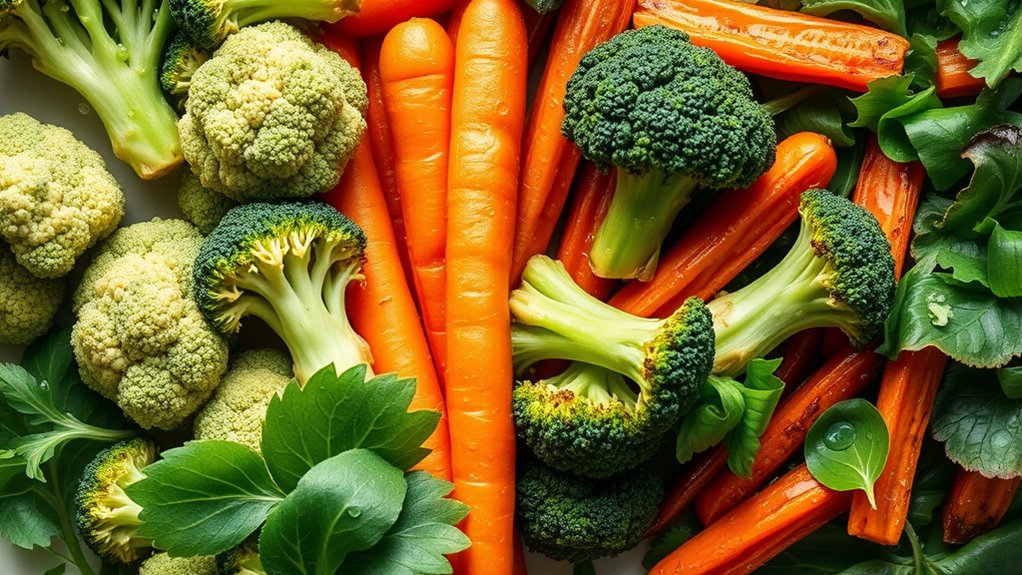
Different cooking methods can substantially influence how well nutrients are preserved in foods. For example, boiling may lead to nutrient loss through leaching, while steaming helps retain more vitamins. Grilling and roasting often enhance flavor, making foods more appealing, but can also cause nutrient degradation if cooked at high temperatures too long. Plus, cooking can modify texture, transforming raw produce into tender, palatable dishes. These changes affect not only taste but also nutrient availability. Sautéing preserves nutrients better than frying, thanks to shorter cooking times and less oil use. Additionally, cooking temperature plays a crucial role in nutrient retention, with higher temperatures increasing the risk of nutrient degradation. Proper cooking techniques can help minimize nutrient loss. Ultimately, choosing the right method balances flavor enhancement with nutrient preservation. Understanding how each technique impacts nutrients helps you make smarter choices, ensuring your meals are both delicious and nutritious.
How Preparation Techniques Alter Fiber and Digestibility
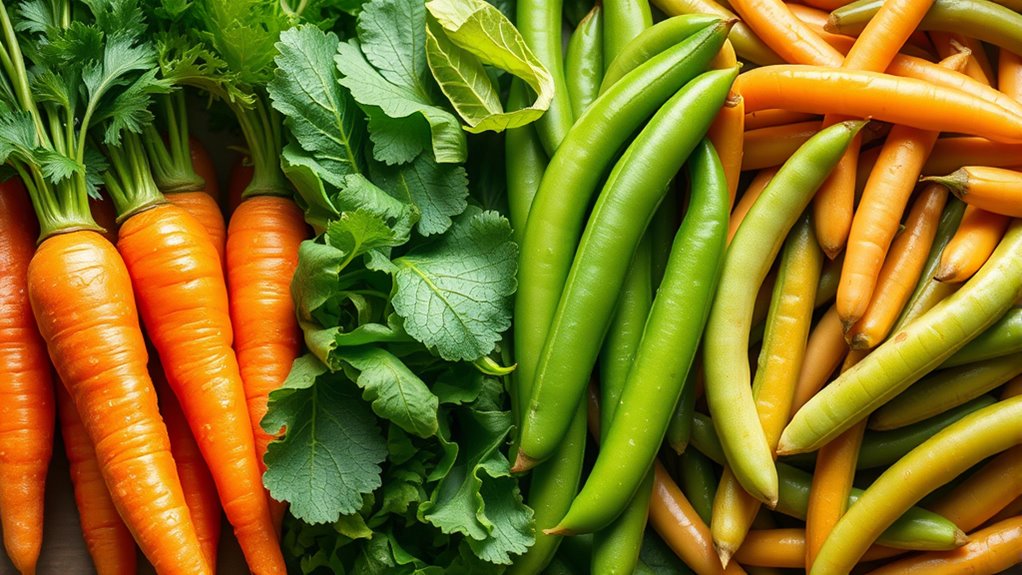
Preparation techniques can markedly alter the fiber content and how easily your body digests foods. Cooking can break down fiber structure, making it softer and easier to digest, but may also reduce certain fiber components. Conversely, raw foods retain their natural fiber, which can be more resistant to digestion. These digestibility changes influence how your gut processes foods and absorbs nutrients. Imagine biting into a crunchy raw carrot, with its fibrous exterior, versus a cooked carrot that’s tender and easier on your digestive system. The fiber structure becomes less rigid, impacting digestion. This process can:
- Softens tough cell walls
- Breaks down insoluble fiber
- Increases overall digestibility
- Alters fiber’s resistance to enzymes
- Changes the texture and chewiness
- Vetted for maintaining optimal fiber levels during food preparation
Practical Tips for Maximizing Nutrient Intake
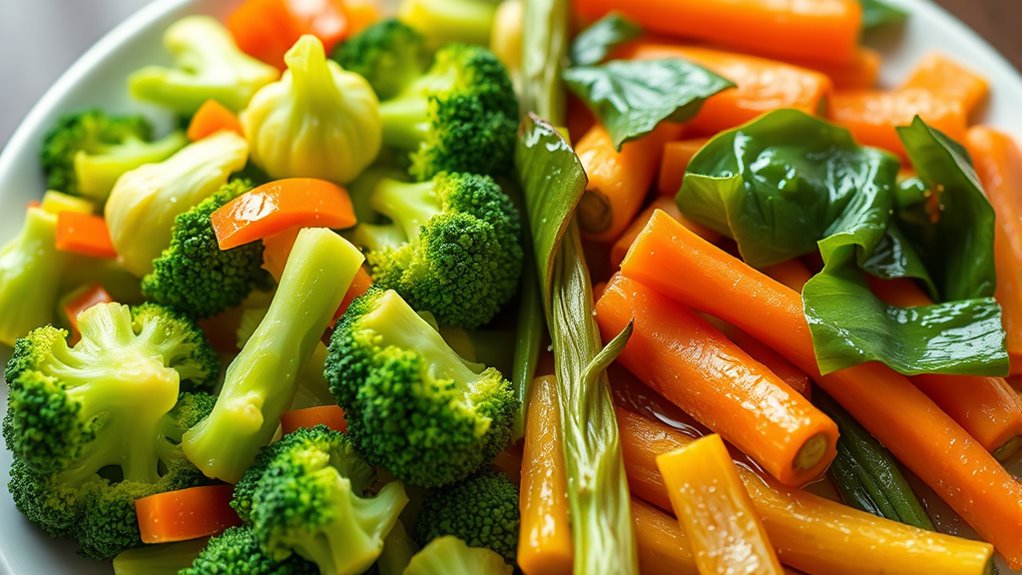
To maximize your nutrient intake, focus on balancing raw and cooked foods based on their nutrient profiles. Incorporate strategic meal planning and food pairing to enhance absorption. For example, pair vitamin C-rich vegetables with iron sources to boost absorption. Also, consider cooking methods that preserve nutrients, like steaming or blanching, for delicate vitamins. Using proper cooking techniques that preserve nutrients can significantly impact your health benefits. Additionally, being aware of how different foods respond to cooking can help you make better choices for nutrient retention.
Frequently Asked Questions
Does Eating Raw Versus Cooked Foods Affect Calorie Content?
When considering your diet, you might wonder if raw versus cooked foods change calorie content. The cooking impact can cause calorie variation, as some foods become easier to digest, making more calories available. Cooking can also reduce water content, slightly increasing calorie density. So, yes, the method of preparation can influence calorie counts, and understanding this helps you better manage your intake and nutritional goals.
How Do Storage Methods Influence Nutrient Retention in Fresh Produce?
Storage techniques profoundly impact nutrient preservation in fresh produce. When you store fruits and vegetables properly—like refrigerating them promptly, avoiding exposure to light, and using airtight containers—you help retain essential nutrients. Proper storage slows down nutrient loss caused by oxidation and spoilage. By choosing the right storage methods, you guarantee your produce stays fresher longer and maintains more of its nutritional value, making your healthy eating habits more effective.
Can Cooking Reduce Harmful Bacteria Without Losing Nutrients?
Cooking can effectively reduce harmful bacteria, improving food safety and lowering the risk of foodborne illnesses. By applying proper cooking methods, you can achieve bacterial reduction without losing significant nutrients if you avoid overcooking. Steaming, boiling, or roasting at appropriate temperatures helps kill bacteria while preserving most vitamins and minerals. Remember, balancing thorough cooking with minimal nutrient loss is key to maintaining both food safety and nutritional quality.
Are There Specific Vegetables Better Eaten Raw or Cooked?
When choosing whether to eat vegetables raw or cooked, consider your vegetable preferences and nutrient stability. Some vegetables, like carrots and tomatoes, retain more nutrients when cooked, making them better options cooked. Others, like spinach and broccoli, maintain their nutrients better raw. Your choice depends on which vegetables you prefer and how you want to maximize nutrient intake. Balancing raw and cooked vegetables offers a variety of flavors and benefits.
How Does Peeling or Chopping Impact Nutrient Levels Before Cooking?
When you peel or chop vegetables, peel nutrient loss can occur because nutrients near the skin, like fiber and vitamins, may wash away or degrade. Chopping increases surface area, leading to more vitamin reduction through oxidation and leaching during cooking. To minimize nutrient loss, peel only when necessary and chop just before cooking. Keeping skins on and minimizing chopping time helps preserve the nutrients you want to maximize from your vegetables.
Conclusion
Did you know that cooking can reduce vitamin C by up to 50%? But don’t worry—by choosing the right methods like steaming or roasting, you can preserve more nutrients. Remember, raw foods retain more vitamins and antioxidants, but cooking enhances mineral bioavailability and digestibility. So, balance your approach to enjoy the best of both worlds. With mindful preparation, you maximize nutrient intake and support your health every day.
Aurelia is the Editor-in-Chief of The Graceful Kitchen, a vegan lifestyle blog that focuses on delicious, nutritious, and ethical eating. A lifelong vegan, Aurelia is passionate about sharing her love of plant-based cuisine with others. She is a regular contributor to several online and print publications, and has been interviewed by major news outlets about the benefits of a vegan diet. In her free time, Aurelia enjoys cooking, hiking, and spending time with her cats.
